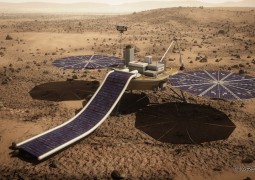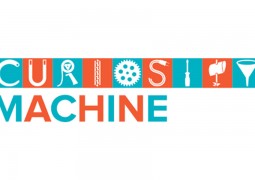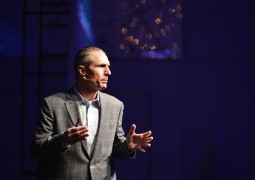Have not you got your brain backup, yet? – Brainhacker – Russell Hanson
by 0

“I get asked this question a lot “Why would a person want to get a backup her brain? “. I think the first reason that resonates with people is the immortality thing.”
I had an excellent interview with Russell Hanson the CEO of Brain Backups, and we talked about Next Generation Brain Hacking at Locard Cyber Security Summit.
 First, let’s learn what Brain Backups do.
First, let’s learn what Brain Backups do.
“Brain Backups, a developmental stage startup, is pursuing one of the biggest scientific and technological discoveries of our time: a map of every connection in the human brain. The connectome, sometimes called the genome of the mind, is the next frontier in neuroscience. Brain Backups is poised to revolutionize neuroimaging technology with cutting-edge micron scale contrast agents; Brain Backups’ technology is capable of imaging at a 1-micron level. That’s 1000x better than today’s best MRIs. Using the AptaMark technology Brain Backups is the first company to develop nondestructive, noninvasive high definition whole brain imaging techniques that do not require the death of the animal. Scanning Electron Microscopy, the traditional method used for connectome mapping, requires the brain to be sliced into incredibly thin pieces, and imaged one at a time.”
When I ask about his company and their near future plans, he explains, “Today we are doing a lot of validation on the chemistry, biochemistry, and imaging itself. It’s a sort of a drug development process, so we have aptamer molecules, and we need to verify them and make sure they do the thing that we want them to do. So, we have to run the screening process on the molecules we want to use for the subsequent imaging runs. We develop these AptaMark contrast agents which are small ligands that are made of DNA sequences. We’re generating a library of AptaMark agents to image the neurological targets in the brain we want right now. In the next 3-4 years, we’ll be validating the AptaMark agents, the imaging methods, and develop computer systems for measuring the AptaMark ligands and their contrast-providing particles in in-vitro and in-vivo systems. That’s our primary push right now.”
I wonder whether they are drugs, but they call them ligands. What is a ligand, then? The ligand for them is usually a sequence of DNA or RNA a macromolecule that fits in a complementary space in the binding target, and that binds selectively. Ligands can be small molecules like drugs, medium-sized molecules like peptides or aptamers, and occasionally entire proteins can act as ligands for transcription factors. *
They focus on the ligands because they need to measure the properties of the neurons. He explains, “Proteins are on the neuron. So if you want to measure the protein on the neuron, then you need to use the ligand. It is a way of measuring the properties of the neuron.” To be able to scan the neuron and synapse in our brain, they use mostly commodity X-ray computed tomography machine (CT) because it gives 3D images of tissue. They do not use MRI’s because the resolution is too low at around 1-5mm.
I wonder if what we have seen in the Johnny Depp movie Transcendence is real. Is it possible to download all the neurons and the synapses of a brain of a human being? The answer is “Yes, using some methods,” he explains, “There are lots of different measurement methods, you could use electrons, optical imaging, CT imaging, or gene sequencing. Those are the types of imaging; people have applied in the past to image through the skull. The imaging method that was used in Transcendence appears to be something like they had to cut up in the scalp, drill a hole in the head, and stick a little sensor, which sees whatever there is. That’s one way to do it. Most likely this method, in the movie, used something like infrared light, or sonar imaging. There is no one, who has done it today but it could happen pretty soon. There are of course substantial technical hurdles, but many of these can be overcome with some creativity, economies of scale, and the appropriate levels of funding.”

It’s hard for me to understand which data is downloaded. He continues with an example, “When you go into surgery, you may be put under deep anesthesia, and will likely lose short term memories that would have been formed if you weren’t under the anesthetic things that happened less than 15 minutes ago. But when you wake up, you retain your long-term memories, things that happened days ago or longer. So, one of the implications of this that you don’t have to record any electronic information but you just have to record the chemical information that encodes your long-term memories. Our employees are experts at measuring the chemical information, the chemicals, and so what we do is we measure the chemical information, and then we associate it with the neuron map, which is also a chemical map. Neuron1 is connected to neuron2, is connected to neuron 3 and so on. We also have the whole bunch of metadata about neuron1, does it transport dopamine, what is the synaptic weight of a synapse connecting to neuron2, what type of neuron is it, and so on. What we have is information on how the neurons are connected and the strength of that connection, which is called the synaptic weight.”
We know about transhumanism projects where avatars will be produced, and the information in the brain will be downloaded into a computer and uploaded to the avatar. So, we will be able to have one to four clones of ourselves wandering around under our control. “Why not? I don’t want to make predictions, but from what I know today about simpler organisms like a worm or a fly; it’s not a big deal to do it with a fly or worm right now. It’s pretty routine. I do it on my laptop every day. Maybe I will need a bigger laptop with more storage. It’s not fundamentally different,” he says.
Why would a person want to get a backup her brain? He responds: “I get asked this question a lot. I think the first reason that resonates with people is the immortality thing. If your physical body ceases to exist, your heart stops, your brain goes into a vegetative state because it lost its oxygen supply, you get Alzheimer’s, cancer, these diseases or conditions will affect the state of your brain and likely make you not yourself. So in a way, by getting a brain backup, you are preserving who you are, at hopefully a healthy, productive, compassionate condition, in defense against all these factors that you may not be able to control. A car could hit you as you cross the street tomorrow and who will provide for your kids, or parents? There are so many things we can’t control, and so much effort has gone into trying to preserve our healthy bodies: biotech, the pharmaceuticals industry, the healthcare industry, the safety industry, the war industry. Human beings have done and created an enormous assortment of methods to protect ourselves, to protect our existence. But if you dig a little deeper to the cause, to the root of our existence, it is certainly our minds. Many people think the next hundred years will be the century when we have solved enough of our other problems. And they have begun to address the problem of imaging the human mind at a resolution where the cells, their types and connectivity is no longer simply a technical challenge, it is the foundation of new technologies.” He continues,
“Also, a laundry list of what is possible if the brain can be measured and modulated in a controlled way include;
- Education through brain circuit re-wiring,
- Telepathy through radio waves, Wi-Fi, cellular data,
- Entertainment where the neurotransmitters themselves are modulated such as dopamine or serotonin, instead of indirectly by TV or film drama or GoPro-shot YouTube videos
- Creativity where instead of making mind maps on a PC.
They can be done amongst multiple minds with exponential connectivity.”
What happens if we print a brain with a 3D printer and upload the data of a human in it?
“I don’t think that 3D printing the brain is a right approach, there are a lot of issues. To keep cells alive is tough, getting them to grow in the right way is more difficult and getting them to do what you want is a harder. So, I don’t personally have a lot of interest in 3D printing cells – other people do. It’s a kind of something I do not want to work on.”
Is it an ethical issue for him?
“No, it’s just too messy. I don’t think it works very long. When you look at the 3D-printed organs, all they have is like a central scaffold and then may just put some cells on top of it, make them differentiate from stem cells. So, they don’t have any of the structure, circuitry, or complexity that you have you tried to grow different brain regions because it’s an entirely different organ and no one yet has ever built developed a 3D brain in the lab.”
He is positive about using the stem cells to print for other organs like a kidney or liver as long as the human brain is not built. We shall not let someone die when we can save the life. He believes that it will not be possible anytime soon to build a human brain, but that imaging and modulating that image will more likely occur earlier.
 Is it probable to control a brain telepathically?
Is it probable to control a brain telepathically?
His answer is, “Yes, by using electrical and chemical signals the brain just responds. Presently there’s no good way to interface to human brains. This device – a wireless 64 electrode-electrocorticographic (ECoG) implant with 64 stimulating and recording electrodes would potentially allow for something like telepathic communication. 64 electrodes are very few indeed, with closer to 10,000 the fidelity will be much improved. When you check the definition of telepathic, it says it’s a communication from one person to another using means other than the known senses. It’s not all that different from texting, but the interface to the smartphone is a different one. Sure, no problem!”
Brain Backups develops ligands to measure pathology in the brain and provides research contrast agents for Parkinson’s and Alzheimer’s diseases, which allow imaging of particular features like addiction biomarkers. In Parkinson’s disease loss of dopaminergic neurons is measured with a contrast agent for dopaminergic neurons in the substantial nigra. ** They measure the stages, how far along the disease is and how a patient responds to therapy usually with CT and MR imaging.
The answer to the question ‘Do you treat the illness?’ is “The contrast agent is not a therapy it’s an imaging agent. You could see what’s happening better so you can treat it better. It’s not like a magic drug. So, today we only scan.”
In his presentation, he shares a video about decoding visual cortex and auditory cortex. The link of the video is
Scientists use brain imaging to reveal the movies in our mind
He explains, “Decoding visual cortex is done usually using MRI machines which measure brain activity. A test subject is placed in the MRI machine and watches images on a TV. Then you make a computer model of their brain scan analyzing regions of brain activity and what they were seeing, and you try to use the computer to model to predict what they are watching. I think that indeed, treatment for many diseases are just getting better and better. Scientists and doctors are breaking down different subtypes of the disease so that they can treat with certain drugs right now. Similarly, with Alzheimer’s disease, today there are five different main types. Once you understand the characteristics, then you can address it more precisely. This field is called precision medicine. In the business world, in pharmacy and biotech, there’s so much money to be made. So it’s just happening very fast.”
The good part of the story is that humans, who will have the chance to use those technologies will live longer. I wonder if Russell Hanson would love to live till 100 to 120 years old. This time, he asks me: “There is a funny question would you rather live with a mind of a senior citizen or with a body of a young person? Like 80-year-old body with the mind of a 20-year-old or 80-year-old mind with the body of 20 years old.”
We agreed that we would like to have an older brain with a younger body: at age 80 with a body of a 20-year-old with the mind of a healthy elderly person! We chose to trust the fact that there are people whose minds are perfectly sharp at 75 or 80.
Which would you prefer? J
Notes:


